Pros
Cons
Introduction
The W610 is available for pre-order now, and should start shipping in early February. It comes in green, black, blue, pink, or silver, and it is one of three new cameras in the Cyber-shot family. The DSC-W620 and DSC-W650 are slightly more expensive, but both include a few features that are absent on the DSC-W610.
Design & Appearance
{{section_header}}{{section.name}}{{/section_header}}
Do you like to choose from a variety of different color options for your camera? Well, the DSC-W610 comes in five different shades: green, black, blue, pink, and silver. It's not a ton of colors to choose from, but it's a pretty good set. Other than the color options, the W610 is a fairly basic model. The LCD takes up about 3/4 of the back of the camera, the buttons line up to its right (and are rather cramped), and the body is built from durable brushed metal.
Tour
{{section_header}}{{section.name}}{{/section_header}}




Menu
{{section_header}}{{section.name}}{{/section_header}}
The menu system on the W610 is good for getting started, as its big text and icons are easy to read. If you're looking for some of the W610's special controls, however, you have to kinda sift through the menu a bit to find what you need. This can be a bit tedious, and we weren't always impressed by the tiny d-pad on the back of the camera for menu navigation, but it was certainly doable.
Ease of Use
{{section_header}}{{section.name}}{{/section_header}}
The DSC-W610 is a small, compact camcorder, so it shouldn't look overwhelming to most people when they get their hands on it. The menu system is easy to read, which is another plus for people who don't want to deal with a complicated camera. If you're simply gonna point and shoot with the W610, you shouldn't run into much trouble. The camera is easy to use for that kind of thing. The only problem we ran into was the fact that the shutter button was so small that it was hard to get a good feel for it. We tried to press it down halfway to focus on an image, and the shutter button didn't really respond all the time. Since that's the most important button on the camera, and probably one of the only buttons many people are going to use, it should probably have a better build.
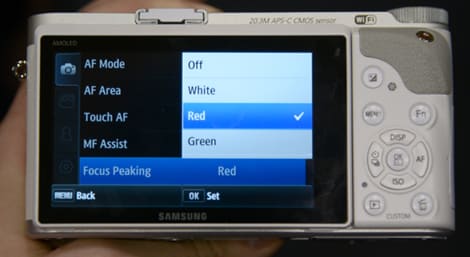

Size & Handling
{{section_header}}{{section.name}}{{/section_header}}
As a small, budget camera, the W610 handles no different than its big brother, the DSC-W650, or the middle-child in Sony's newest Cyber-shot family, the DSC-W620. All three cameras are nearly identical in size, shape, and weight, and you'd probably have a tough time telling them apart except for the different paint jobs available for each camera.
The dimensions for the W610 are as such: 93 x 52.4 x 19mm and a weight of 113g (including battery).
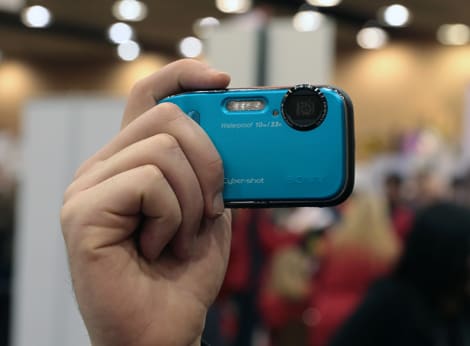
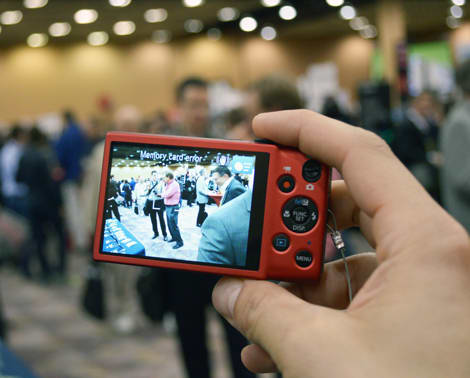
Modes Overview
{{section_header}}{{section.name}}{{/section_header}}
Going into the menu system, you'll find one of the first options involves switching the camera between iAuto (the dedicated auto mode), Program Auto, Picture Effects, and Scene Modes. Each of these "modes" has its own shooting benefits: the iAuto mode lets the camera handle all the controls automatically, Program Auto gives you access to more manual controls (while maintaining automatic aperture and shutter speed adjustment), Picture Effects gives you a set of digital effects to play with, and Scene Modes lets you choose a specific shooting mode to match the situation your taking photos of.
A second mode slider on the back of the camera switches between three other modes for the W610. Here you can alternate between photo mode (for capturing still images), video mode (for recording standard definition video), and a panorama setting (for using Sony's Sweep Panorama feature). This slider is easy to access and can be easy to accidentally bump. Luckily, the slider takes some force to switch up and down, so it's unlikely that accidentally touching it will result in the slider changing position.

Auto Mode
{{section_header}}{{section.name}}{{/section_header}}
If the dedicated auto mode, iAuto, isn't simple enough for you, you can also put the camera into Easy mode for an even simpler user experience. Easy mode increases the font size of the menu, removes complicated menu options, and maintains the automatic controls that are put in power in iAuto mode. The feature works well for someone who is afraid of accidentally changing a control they never wanted to change in the first place, but anyone with a bit of camera know-how will likely feel constrained by the Easy mode's simplified options.
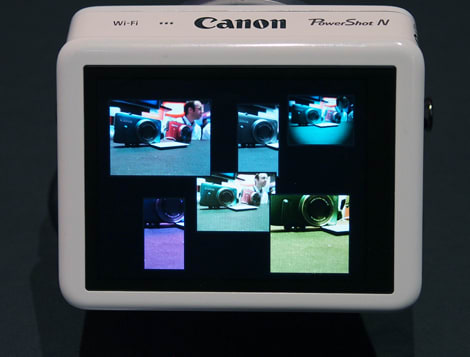
Movie Mode
{{section_header}}{{section.name}}{{/section_header}}
One of the biggest differences between the W610 and its step-up sibling models (the W620 and W650) is the camera's lack of an HD video recording option. You can record video with the DSC-W610, but the resolution is limited to 640 x 480, which is standard definition (as opposed to 720p HD on the W620 and W650). You can also shoot at an even smaller 320 x 240 resolution, which will create very small video files that are good for sharing over email. But the main point here is if you want HD recording options from your Cyber-shot, you'll have to spring for a higher-end model.
Drive/Burst Mode
{{section_header}}{{section.name}}{{/section_header}}
A full-resolution burst mode is present on the DSC-W610, but the camera is limited to one photo per second and a maximum of 100 shots per burst. The DSC-W620 and DSC-W650 have the same burst limitations as the W610 (but both cameras can take higher-resolution images in their respective burst modes).
Playback Mode
Picture Quality & Size Options
{{section_header}}{{section.name}}{{/section_header}}
The DSC-W610 shoots JPEG images at a maximum resolution of 14 megapixels (4320 x 3240). This the same maximum photo size as the DSC-W620 is capable of, but it's a notch lower than the 16-megapixel size option offered on the DSC-W650 camera.
Other photo size options include two 16:9 photo settings (4302 x 2432 and 1920 x 1080) and four 4:3 options (4320 x 3240, 3648 x 2736, 2592 x 1944, and VGA). There are also five different size options for taking panorama images with the W610's Sweep Panorama setting.
Other Modes
{{section_header}}{{section.name}}{{/section_header}}
The Sweep Panorama feature on the W610 is a mode that Sony includes on many of its digital cameras, but it makes for a strong selling point on a budget camera. The panorama setting allows you to take multiple photos by holding down the shutter button, and then the camera will stitch these photos together automatically (thus creating one unified panorama). In this mode, you can switch between different panorama sizes, going all the way up to 360° sweeps that create a 11520 x 1080 image. Lower sizes include two "wide" panoramas (7152 x 4912 or 4912 x 1920) and two "standard" panorama images (4912 x 1080 or 3424 x 1920).
Focus
{{section_header}}{{section.name}}{{/section_header}}
The DSC-W610, like most budget cameras, has no option for controlling focus manually. There's no manual lens ring, no buttons on the back for pulling focus, and no focus dials anywhere on the device. So, you must use autofocus to bring your image into focus. But that's what most budget camera owners will probably want to use anyway.
The camera has three autofocus modes: Multi Point (uses a variety of focus points to focus the image), Center Weighted (changes focus based mostly on the center of the frame), and Spot focus (allows you to pick a spot in the frame to use as a focal point). Generally, the focus wasn't all that fast when we tested it out on the W610 at CES, but part of our problem stemmed from the poorly-designed shutter button that was hard to press halfway down (to kick in the autofocus mechanism).
Exposure & Metering
{{section_header}}{{section.name}}{{/section_header}}
You won't find manual aperture or shutter speed control on the W610, but you can make basic exposure adjustments on a -2 to +3 scale (with 1/3 EV steps). The camera has three auto exposure metering modes that are essentially the same as the camera's three autofocus modes: Multi Pattern, Center Weighted, and Spot.
Printed on the front of the W610's lens is an aperture range of f/2.8 to f/5.9, and, according to Sony the camera has a shutter speed range of one second to 1/1600 of a second. Neither of these settings can be adjusted manually, remember, so this is simply the range the camera's auto exposure system gets to choose from.
ISO
{{section_header}}{{section.name}}{{/section_header}}
The ISO range for the DSC-W610 goes from ISO 80 to ISO 3200, which is a solid range for a camera expected to retail for just a tad over $100.
White Balance
{{section_header}}{{section.name}}{{/section_header}}
Like most Cyber-shot cameras, the Sony W610 has six white balance presets (Daylight, Cloudy, 3 Fluorescent settings, Incandescent light, and Flash). The camera does not, however, have a manual white balance setting, which is something you do get on the higher-end DSC-W650. So, if manual white balance is important to you, then you may want to consider spending the extra $30 bucks for the W650 instead of saving cash with the more limited W610.
Image Stabilization
{{section_header}}{{section.name}}{{/section_header}}
The W610 has Sony's SteadyShot image stabilization system, but the IS on the W610 doesn't appear to be optical in nature (at least according to Sony's specs). This leaves us with another difference between the DSC-W610 and its more expensive big brother (the DSC-W650, which has an optical stabilization system).
Picture Effects
{{section_header}}{{section.name}}{{/section_header}}
Unlike optical image stabilization and manual white balance, Sony chose not to leave off the picture effects on its cheapest new Cyber-shot camera. The W610 still has the fun Toy Camera and Pop Color picture effects modes that you also get on its more-expensive siblings, the W620 and W650.
Lens & Sensor
{{section_header}}{{section.name}}{{/section_header}}
Strangely, Sony uses three (slightly) different lenses on its new Cyber-shot cameras. The DSC-W610 has an f/2.8 lens with a 4.7 - 18.8mm focal length and a 5x optical zoom. The DSC-W620 and DSC-W650 each offer 5x zoom lenses, but the focal length ranges are a tiny bit different on both. The differences probably aren't significant enough to make a huge difference, but it does mean that the quality of the lenses could vary between the models (they are three different lenses, after all).
The image sensor is a 1/2.3-inch CCD with a total pixel count of 14.5 megapixels and an effective pixel count of just over 14 megapixels. This appears to be the same sensor as what Sony includes on the W620, while the W650 uses a sensor with 16 million effective pixels.

LCD
{{section_header}}{{section.name}}{{/section_header}}
The screen is a 2.7-inch LCD with a limited 230k-pixel resolution. That's a tad smaller than the 3-inch screen you'll find on the DSC-W650, but it's the same screen you get on the W620. We don't care about the screen size all that much, however, as we'd rather have a better resolution so we can see more detail in the photos being shot with the camera. The meager 230k screen simply doesn't do your photos justice when you view them in playback mode

Flash
{{section_header}}{{section.name}}{{/section_header}}
Sony calls the W610's flash a "natural flash", which seems to be a reference to the fact that the camera uses a flash white balance setting to accommodate for the change in color temperature established when using a flash. The flash also includes red-eye reduction, a slow synchro setting, and an automatic function.

Jacks, Ports & Plugs
{{section_header}}{{section.name}}{{/section_header}}
There's a single port on the side of the W610 that works with the camera's mult-USB cable for USB output to a computer or for AV output to a television. There's no HDMI output on the camera, but that's OK because you can't shoot HD video with the camera either.
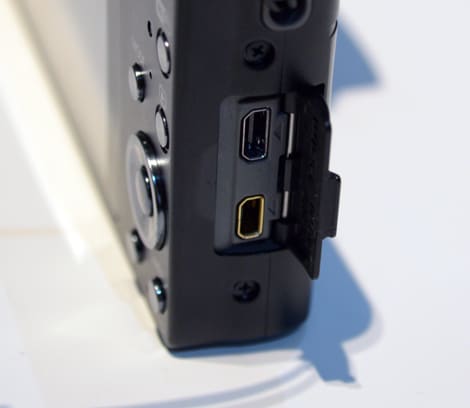
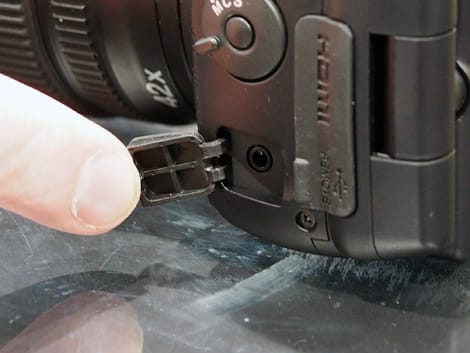
Battery
{{section_header}}{{section.name}}{{/section_header}}
The battery compartment is on the bottom of the DSC-W610, and the camera comes with an NP-BN rechargeable battery pack as well as a battery charger.

Memory
{{section_header}}{{section.name}}{{/section_header}}
The camera works with Memory Stick or SD-type memory cards (in the same card slot). The card slot is located inside the battery compartment and the W610 also functions with new, higher-capacity SDXC memory cards.

Conclusion
With the Cyber-shot DSC-W610 everything comes down to price. The camera costs just over $100, which makes it the most affordable cameras on the market, and definitely the cheapest new model Sony announced at CES. Sony kept the price down by making the W610 a simple camera. It doesn't have the flashy features and controls that you get on higher-end cameras, but it's got everything you need if all you want to do is point and shoot.
The big question about the DSC-W610 will be image quality. If the camera comes through our labs and shows us lackluster performance across the board, then it probably won't be a model we'll recommend. Sure, we can say that about every camera, but the Sony DSC-W610 needs to prove to us that it takes better photos than your cell phone camera before we can justify buying one.
There's a few nifty features on the W610, like Sony's Sweep Panorama function, a 5x optical zoom, and a simple interface with easy-to-read menus, but nothing about the DSC-W610 really wowed us. In fact, the most exciting thing about the camera may be the various paint jobs available to choose from (we liked the green one in particular). If you want a few extra features, like 720p HD video recording instead of a standard definition video mode, you can spring for the Cyber-shot DSC-W620 or DSC-W650 instead. All you have to do is pony up a bit more cash ($20 extra for the W620; $30 extra for the W650), and you can get one of the W610's higher-end siblings instead.
{{product.vanity}}
Sample Photos
{{section_header}}{{section.name}}{{/section_header}}
Specs
{{manufacturer_specs_table}}
Meet the tester
Jeremy is the video expert of our imaging team and Reviewed.com's head of video production. Originally from Pennsylvania and upstate NY, he graduated from Bard college with a degree in film and electronic media. He has been living and working in New England since 2005.
Checking our work.
Our team is here to help you buy the best stuff and love what you own. Our writers, editors, and experts obsess over the products we cover to make sure you're confident and satisfied. Have a different opinion about something we recommend? Email us and we'll compare notes.
Shoot us an email